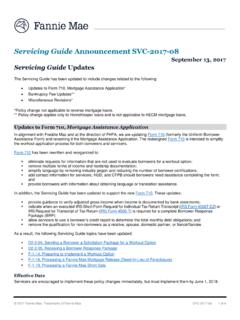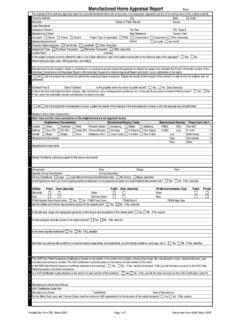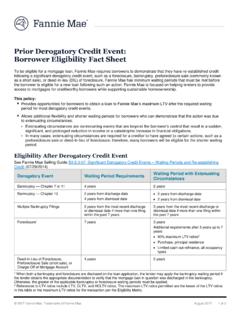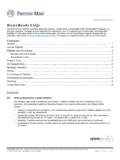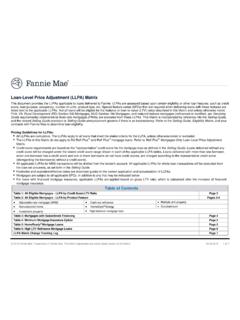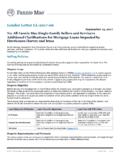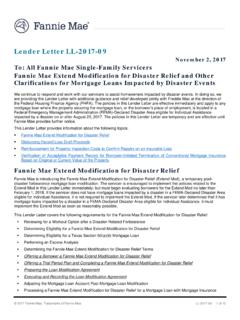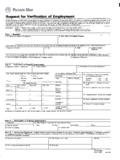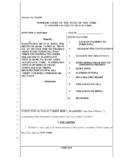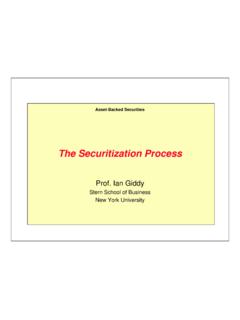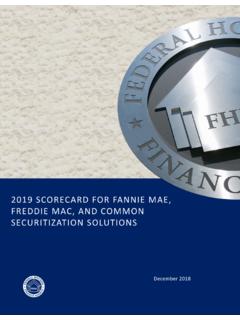Transcription of Basics of Fannie Mae Single-Family MBS
1 January 2019. Basics of Fannie Mae Single-Family MBS 2018 Fannie MAE. 1. MBS Overview Creating a Single-Family MBS begins with a mortgage loan. The loan is made by a financial institution or other lender to a borrower in order to finance or refinance the purchase of a home or other property consisting of one to four residential units. These loans are made under varying terms ( , 15-year, 30-year, fixed-rate, adjustable-rate, etc.). During the life of the loan, the balance is generally amortized, or reduced, until it is paid off. The borrower usually repays the loan in monthly installments that typically include both principal and interest. The direct lending of funds to mortgage borrowers and creation of loans is known as the primary mortgage market. In the secondary mortgage market, lenders exchange those loans for mortgage-backed securities (MBS). As a secondary market participant in MBS, Fannie Mae does not lend directly to borrowers. We are a government-sponsored enterprise (GSE).
2 Chartered by Congress to provide liquidity, increase stability and promote affordability in the residential mortgage market. The founding Congressional charter, passed in 1954, allows Fannie Mae to accomplish this by charging a fee to guarantee the credit-worthiness of certain mortgage loans that meet specific GSE requirements. Fannie Mae ensures that the loans it acquires meet its credit quality and maximum loan size (or conforming-balance limit ) guidelines and then converts, or securitizes, them into a pool of mortgages. The resulting Fannie Mae MBS (also referred to as Agency MBS) carries a guaranty of timely payment of principal and interest to the investor by Fannie Mae, whether or not there is sufficient cash flow from the underlying group of To provide even more liquidity to the mortgage investment market, Fannie Mae began securitizing loans and issuing mortgage-backed securities in the 1980s. Our participation in the mortgage market enables consumers to attain more favorable rates to buy homes, refinance their existing mortgages, or access affordable rental housing.
3 Securitization of Loans Fannie Mae currently securitizes a substantial majority of the mortgage loans we acquire. The securitization transactions primarily fall within three broad categories: lender swap transactions, portfolio securitizations, and structured securitizations. 1. It should be noted that Fannie Mae's obligation under this guaranty is solely Fannie Mae's and is not backed by the full faith and credit of the government. Basics of Fannie Mae Single-Family MBS 2019 Fannie MAE. 2. Lender Swap Transactions Lender swap transactions are the most common type of securitization for Fannie Mae. Let's look at an example: In a Single-Family lender swap transaction, an approved mortgage lender delivers a pool of mortgage loans to us in exchange for Fannie Mae MBS backed by these loans. Lenders may hold the Fannie Mae MBS they receive from us, or sell the MBS to investors. After receiving the mortgage loans in a lender swap transaction, we place them in a trust for which we serve as trustee.
4 This trust is established for the sole purpose of holding the mortgage loans separate and apart from our corporate assets. We deliver to the lender a Fannie Mae MBS or a proportional share of a Fannie Majors pool; that is, a large MBS. consisting of loans contributed by more than one lender. This transaction is commonly referred to as a swap.. The MBS is backed by the pool of mortgage loans in the trust and represent an undivided beneficial ownership in each of the mortgage loans. We guarantee to each MBS trust that we will supplement the amounts received to ensure timely payment of principal and interest on the related Fannie Mae MBS. We retain a portion of the interest payment as a fee for providing our guaranty. Basics of Fannie Mae Single-Family MBS 2019 Fannie Mae 3.. The mortgage servicer also retains a portion of the interest payment as a fee for servicing the loan. Then, on behalf of the trust, we make monthly distributions to the Fannie Mae MBS certificate holders from the principal and interest payments and other collections on the underlying mortgage loans.
5 Portfolio Securitization Transaction Portfolio Securitizations In contrast to lender swap transactions, our portfolio securitization transactions involve creating and issuing Fannie Mae MBS using mortgage loans and mortgage-related securities that we hold in our retained mortgage portfolio. Most of our portfolio securitization transactions are driven by our Single-Family Whole Loan Conduit activities. Here, we purchase single - family whole loans directly from over 1,200, typically smaller lenders, and securitize them into Fannie Mae MBS or deliver into a Fannie Majors pool, which may then be sold to dealers and investors in the secondary market. Structured Securitizations In a structured securitization transaction, we create structured Fannie Mae MBS in exchange for a transaction fee. In these transactions, the customer swaps a mortgage-related asset that it owns (typically a mortgage security) in exchange for a structured Fannie Mae MBS we issue.
6 For all types of these securitizations, Fannie Mae issues MBS and assumes the default risk on the mortgages underlying the security, while guaranteeing to an MBS trust the timely payments of principal and interest, even if the borrower defaults on the mortgage payments. Fannie Mae accomplishes this by remitting payments directly to the MBS trust to supplement any cash flow shortfalls to the investor. In the event of a default, once a loan is delinquent for four or more consecutive months, Fannie Mae will typically repurchase the loan out of the trust at a par dollar price ($100-00, or 100 cents per $1. of principal balance) and place it on our balance sheet. Fannie Mae then works with the loan's servicer to address the delinquency through a number of loss mitigation options with the borrower. Basics of Fannie Mae Single-Family MBS 2019 Fannie Mae 4.. Credit Quality and the Fannie Mae Guaranty The quality and value of Fannie Mae MBS depend on several major considerations: Fannie Mae's guaranty to the MBS trust of full and timely payment of both principal and interest The investment quality of the underlying mortgages The financial strength behind the guaranty The guaranty is important to investors because it reduces risk and increases the marketability of the MBS.
7 The certificates and payments of principal and interest on the certificates are not guaranteed by the United States and do not constitute a debt or obligation of the United States or any of its agencies or instrumentalities other than Fannie Mae. Thus, it is important that Fannie Mae uses prudent underwriting guidelines to evaluate the credit quality of the loans it guarantees to minimize losses to its investors. While Standard & Poor's, Fitch and Moody's have not rated any of the MBS issued directly by Fannie Mae, securities collateralized by Fannie Mae MBS and issued by other entities are rated consistently as Triple A (AAA), the highest quality. In addition, Fannie Mae MBS are assigned a 20% risk-based weighting under Basel accounting rules, which determine capital reserve requirements for banking entities. A 20% risk- weighting places Fannie Mae MBS in an asset category generally considered to be of very high credit quality. Fannie Mae MBS offer investors high quality assets with attractive yields to fit their portfolio needs or investment strategies.
8 Investors should exercise care to fully understand the value of any mortgage investment and diligently review the applicable disclosure documents. Furthermore, they may wish to discuss the potential risks versus rewards of investing in MBS with their investment advisors. MBS Risk Considerations: Prepayment Risk is the risk that borrowers may prepay their mortgages more quickly or slowly than expected, thereby affecting the investment's average life and perhaps its yield. Most mortgages can be prepaid in whole or in part at any time without penalty and borrowers are most likely to exercise the prepayment option at a time when it is least advantageous to investors. Interest Rate Risk is the risk that the price of the security may fluctuate over time. For MBS, prepayment risk and interest rate risk are closely intertwined. The price of any bond, including MBS, is a function of several factors such as prevailing interest rates, the coupon rate, the length of time the security is expected to be outstanding, and the liquidity of the issue, all of which can fluctuate with market conditions.
9 Interest rate movements have a greater impact on MBS than traditional fixed income investments because of the borrower's prepayment option. This can affect the average life and yield of MBS as well as the returns from reinvesting principal. Credit Risk is the risk that the investor may not receive all or part of the principal invested because the borrower(s) of the underlying mortgage loan(s) defaulted on their financial obligations. Fannie Mae MBS have reduced credit risk because they carry a guaranty of timely payment of both principal and interest. Fannie Mae's obligations under this guaranty are based on the financial health of the corporation and are not backed by the full faith and credit of the government. Basics of Fannie Mae Single-Family MBS 2019 Fannie Mae 5.. Mortgage Pass-through Certificates MBS are commonly referred to as mortgage pass-through certificates. This is because the security passes through to investors, at a specific coupon, scheduled principal and interest each month on the outstanding balance of the loans backing the security, along with any unscheduled prepayments.
10 As a Fannie Mae MBS investor, the certificateholder receives a pro- rata distribution of the scheduled principal and interest payments on the 25th day of each month, or if the 25th day is not a business day, on the first business day following the 25th day of the month, which is referred to as the distribution date. Fannie Mae will make the first payment for newly issued certificates on the distribution date in the month following the month in which the certificates are issued. Fannie Mae's central paying agent, the Federal Reserve Bank of New York, is responsible for wiring monthly payments to depository institutions on behalf of the registered security holders. Fixed-Rate Mortgage (FRM) MBS. Fannie Mae's fixed-rate MBS are securities backed by pools of mortgages with interest rates that are fixed for the entire term of the mortgage. Certificates for fixed-rate MBS are normally issued in 50 basis point increments ( , , , etc.). The coupon that is paid to the investor is known as the pass-through rate and is lower than the interest rate paid by the borrower on the underlying loans.

